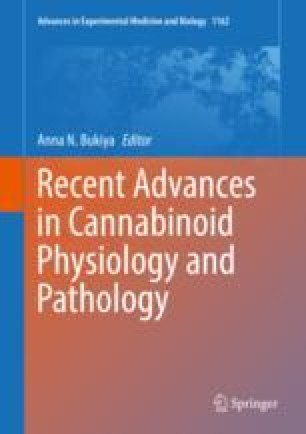 “Δ9-tetrahydrocannabinol (Δ9-THC), the primary active component in Cannabis sativa preparations such as hashish and marijuana, signals by binding to cell surface receptors. Two types of receptors have been cloned and characterized as cannabinoid (CB) receptors. CB1 receptors (CB1R) are ubiquitously present in the central nervous system (CNS) and are present in both inhibitory interneurons and excitatory neurons at the presynaptic terminal. CB2 receptors (CB2R) are demonstrated in microglial cells, astrocytes, and several neuron subpopulations and are present in both pre- and postsynaptic terminals.
“Δ9-tetrahydrocannabinol (Δ9-THC), the primary active component in Cannabis sativa preparations such as hashish and marijuana, signals by binding to cell surface receptors. Two types of receptors have been cloned and characterized as cannabinoid (CB) receptors. CB1 receptors (CB1R) are ubiquitously present in the central nervous system (CNS) and are present in both inhibitory interneurons and excitatory neurons at the presynaptic terminal. CB2 receptors (CB2R) are demonstrated in microglial cells, astrocytes, and several neuron subpopulations and are present in both pre- and postsynaptic terminals.
The majority of studies on these receptors have been conducted in the past two and half decades after the identification of the molecular constituents of the endocannabinoid (eCB) system that started with the characterization of CB1R. Subsequently, the seminal discovery was made, which suggested that alcohol (ethanol) alters the eCB system, thus establishing the contribution of the eCB system in the motivation to consume ethanol. Several preclinical studies have provided evidence that CB1R significantly contributes to the motivational and reinforcing properties of ethanol and that the chronic consumption of ethanol alters eCB transmitters and CB1R expression in the brain nuclei associated with addiction pathways.
Additionally, recent seminal studies have further established the role of the eCB system in the development of ethanol-induced developmental disorders, such as fetal alcohol spectrum disorders (FASD). These results are augmented by in vitro and ex vivo studies, showing that acute and chronic treatment with ethanol produces physiologically relevant alterations in the function of the eCB system during development and in the adult stage. This chapter provides a current and comprehensive review of the literature concerning the role of the eCB system in alcohol abuse disorders (AUD).”
https://www.ncbi.nlm.nih.gov/pubmed/31332736
https://link.springer.com/chapter/10.1007%2F978-3-030-21737-2_6
